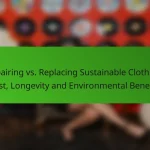Vintage and thrift shopping presents a wealth of benefits, from significant cost savings to the discovery of one-of-a-kind items, all while promoting environmental sustainability. By exploring local stores and utilizing online resources, shoppers can find unique treasures that not only enhance their personal style but also support local economies. This approach to shopping encourages a more sustainable lifestyle by prioritizing reuse over new purchases.

What are the benefits of vintage and thrift shopping?
Vintage and thrift shopping offers numerous advantages, including cost savings, unique items, and positive environmental impacts. These benefits make it an appealing choice for budget-conscious consumers and those seeking distinctive styles.
Cost savings
One of the primary benefits of vintage and thrift shopping is the significant cost savings. Items in thrift stores are typically priced much lower than new retail products, often ranging from 50% to 90% off original prices. This affordability allows shoppers to stretch their budgets further while acquiring quality goods.
Additionally, many thrift shops offer sales or discounts on certain days, further enhancing savings. Shoppers should keep an eye out for these promotions to maximize their budget.
Unique finds
Vintage and thrift stores are treasure troves of unique finds that cannot be replicated in mainstream retail. Shoppers often discover one-of-a-kind clothing, accessories, and home decor that reflect personal style and history. This uniqueness allows individuals to express themselves creatively through their purchases.
Moreover, the variety in vintage items can lead to interesting conversations and connections with others who appreciate distinctive styles. Each piece often has a story, adding to its charm and value.
Environmental impact
Thrift shopping plays a crucial role in reducing waste and promoting sustainability. By purchasing second-hand items, consumers help divert clothing and goods from landfills, which is beneficial for the environment. This practice reduces the demand for new production, which can be resource-intensive.
Choosing vintage or thrifted items also encourages a circular economy, where products are reused and repurposed rather than discarded. This shift contributes to lower carbon footprints and less environmental degradation.
Support for local businesses
Shopping at thrift stores often means supporting local businesses and charities. Many thrift shops are operated by non-profit organizations, with proceeds going towards community services and initiatives. By purchasing from these stores, consumers contribute to their local economy and help fund valuable programs.
Additionally, local thrift shops often provide jobs and training opportunities for community members, further enhancing their positive impact on the area.
Fashion sustainability
Vintage and thrift shopping promotes fashion sustainability by encouraging consumers to choose pre-owned items over fast fashion. This shift helps combat the negative effects of the fast fashion industry, which is known for its environmental harm and labor issues.
By opting for second-hand clothing, shoppers not only save money but also make a conscious choice to support ethical fashion practices. Embracing vintage styles can lead to a more sustainable wardrobe that values quality over quantity.

How to choose the best vintage and thrift stores in major cities?
Choosing the best vintage and thrift stores in major cities involves researching local options, attending community events, and utilizing online platforms. These strategies help you find unique items while supporting local businesses.
Research local reviews
Start by checking online reviews on platforms like Yelp, Google Maps, or Facebook. Look for stores with consistently high ratings and positive comments about their inventory and customer service.
Pay attention to recent reviews, as they provide insight into the current state of the store. A shop that was once popular may have changed ownership or inventory, affecting its quality.
Visit community events
Community events such as flea markets, pop-up shops, and local fairs often feature vintage and thrift vendors. Attending these events allows you to discover new stores and meet local sellers.
Engaging with vendors can provide valuable insights into their offerings and upcoming sales. Additionally, you may find exclusive items that are not available in regular stores.
Explore online platforms
Utilize online platforms like Instagram, Facebook Marketplace, or Etsy to find vintage and thrift stores in your area. Many shops showcase their inventory online, making it easier to browse before visiting in person.
Look for local hashtags or groups dedicated to vintage shopping to connect with other enthusiasts. This can lead to recommendations for hidden gems and special sales events.

What types of items can you find in thrift stores?
Thrift stores offer a diverse range of items, including clothing, furniture, books, and various household goods. Shoppers can discover unique pieces at affordable prices, often contributing to sustainable practices by reusing items rather than buying new.
Clothing and accessories
Thrift stores are well-known for their extensive selection of clothing and accessories, ranging from vintage garments to contemporary styles. Shoppers can find everything from casual wear to formal attire, often at a fraction of retail prices.
When searching for clothing, consider checking the quality and condition of the items. Look for brands that you recognize, as they may indicate better durability. Accessories like bags, belts, and jewelry can also be found, adding unique touches to your wardrobe.
Furniture and home decor
In addition to clothing, thrift stores frequently stock furniture and home decor items. Shoppers can find everything from sofas and chairs to decorative pieces like vases and artwork. These items often come with character and history, making them appealing for those looking to personalize their living spaces.
When purchasing furniture, measure your space beforehand to ensure a good fit. Inspect items for any damage or wear, and consider the cost of potential repairs. Thrifted furniture can be a cost-effective way to furnish a home while supporting sustainability.
Books and media
Thrift stores often have a dedicated section for books and media, including novels, textbooks, DVDs, and vinyl records. This can be a treasure trove for avid readers and collectors looking for rare finds or classic titles.
Check the condition of books and media before purchasing. Look for any signs of damage, such as torn pages or scratched discs. Prices are typically low, making it easy to build a collection without breaking the bank.

How does vintage shopping impact the fashion industry?
Vintage shopping significantly influences the fashion industry by promoting sustainable practices and reducing reliance on fast fashion. It encourages consumers to seek unique pieces while minimizing environmental impact.
Reduces fast fashion demand
By choosing vintage items, shoppers directly decrease the demand for fast fashion, which is known for its rapid production cycles and environmental harm. This shift helps to slow down the cycle of overconsumption and waste associated with mass-produced clothing.
For example, purchasing a vintage dress instead of a new one can save resources and reduce textile waste. Consumers can play a role in this change by consciously opting for second-hand items, which often have a lower carbon footprint compared to new garments.
Encourages circular economy
Vintage shopping supports a circular economy by extending the life of clothing and reducing the need for new materials. This approach promotes the reuse of garments, which is essential for sustainability in the fashion sector.
When consumers buy vintage, they contribute to a system where clothing is recycled and repurposed, rather than discarded. This practice not only conserves resources but also fosters a culture of valuing quality and craftsmanship over quantity.

What are the best practices for thrift shopping?
The best practices for thrift shopping involve careful inspection of items, knowing your measurements, and maintaining patience and persistence. These strategies help ensure you find quality pieces that fit well and meet your style needs.
Inspect items carefully
When thrift shopping, inspecting items carefully is crucial to avoid purchasing damaged or low-quality goods. Look for signs of wear, such as stains, tears, or broken zippers, which can affect the item’s usability. Pay attention to fabric quality and stitching, as these factors often indicate durability.
Additionally, check for any missing tags or labels that might provide information about the brand or care instructions. If possible, try items on to assess fit and comfort before making a purchase.
Know your measurements
Knowing your measurements is essential when thrift shopping, as sizing can vary significantly between brands and eras. Take the time to measure your bust, waist, hips, and inseam, and keep these numbers handy for quick reference. This practice helps you select pieces that will fit well without needing alterations.
Consider bringing a measuring tape with you or using your smartphone to take measurements of items you are interested in. This can save time and prevent disappointment when trying on clothes later.
Be patient and persistent
Patience and persistence are key traits for successful thrift shopping. It may take several visits to find the perfect items, as inventory changes frequently. Don’t be discouraged if you don’t find what you’re looking for right away; keep checking back regularly.
Additionally, explore different thrift stores in your area, as each may have a unique selection. Being open-minded about styles and brands can lead to unexpected finds that suit your taste and budget.

How to style vintage finds for modern outfits?
Styling vintage finds for modern outfits involves blending unique pieces with contemporary fashion elements. This approach allows you to create distinctive looks that reflect your personal style while embracing sustainability.
Mixing vintage with contemporary pieces
To effectively mix vintage and contemporary items, start by selecting one or two standout vintage pieces, such as a patterned blouse or a classic leather jacket. Pair these with modern staples like tailored jeans or a simple t-shirt to balance the overall look.
Consider the color palette and textures when combining items. For instance, a vintage floral dress can be modernized with a sleek denim jacket and ankle boots, creating a fresh yet nostalgic outfit.
Accessorizing vintage outfits
Accessories play a crucial role in styling vintage outfits. Incorporate modern accessories, such as minimalist jewelry or trendy bags, to update the vintage aesthetic. A vintage scarf can be tied around a modern handbag for a chic touch.
Footwear is another key element. Pair vintage clothing with contemporary shoes, like chunky sneakers or stylish ankle boots, to maintain a modern vibe while showcasing your unique finds.
Layering techniques
Layering is an effective technique for styling vintage pieces. Start with a fitted base layer, then add vintage items like oversized blazers or cardigans. This creates depth and interest in your outfit.
Experiment with different lengths and silhouettes. For example, a long vintage coat can be layered over a modern midi dress, creating a stylish contrast that enhances both pieces.
Choosing the right fit
Fit is essential when styling vintage finds. Many vintage items may not conform to current sizing standards, so it’s important to try them on or check measurements before purchasing. Tailoring can also help achieve a modern silhouette.
Look for vintage pieces that flatter your body shape. A well-fitted vintage dress or tailored trousers can elevate your outfit, making it look intentional and stylish.







